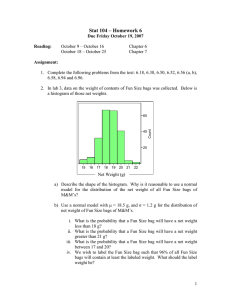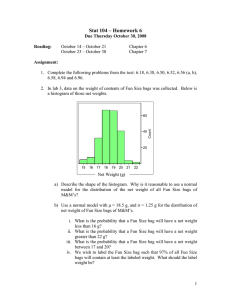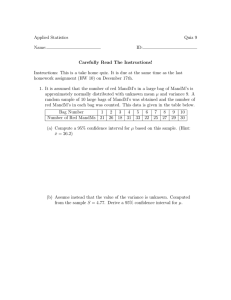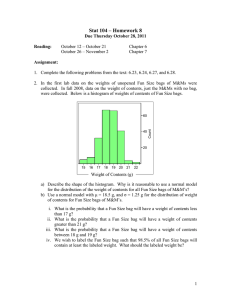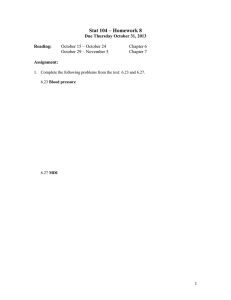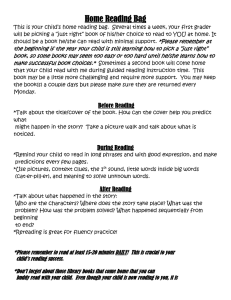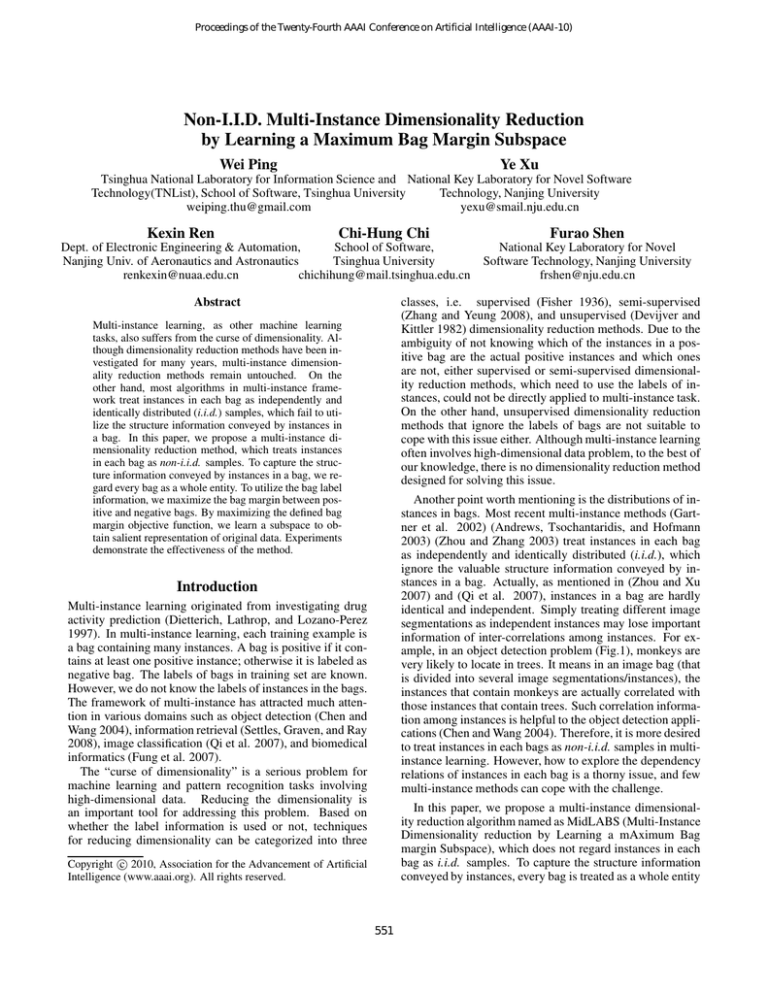
Proceedings of the Twenty-Fourth AAAI Conference on Artificial Intelligence (AAAI-10)
Non-I.I.D. Multi-Instance Dimensionality Reduction
by Learning a Maximum Bag Margin Subspace
Wei Ping
Ye Xu
Tsinghua National Laboratory for Information Science and National Key Laboratory for Novel Software
Technology(TNList), School of Software, Tsinghua University
Technology, Nanjing University
weiping.thu@gmail.com
yexu@smail.nju.edu.cn
Kexin Ren
Chi-Hung Chi
Dept. of Electronic Engineering & Automation,
School of Software,
Nanjing Univ. of Aeronautics and Astronautics
Tsinghua University
renkexin@nuaa.edu.cn
chichihung@mail.tsinghua.edu.cn
Abstract
Furao Shen
National Key Laboratory for Novel
Software Technology, Nanjing University
frshen@nju.edu.cn
classes, i.e. supervised (Fisher 1936), semi-supervised
(Zhang and Yeung 2008), and unsupervised (Devijver and
Kittler 1982) dimensionality reduction methods. Due to the
ambiguity of not knowing which of the instances in a positive bag are the actual positive instances and which ones
are not, either supervised or semi-supervised dimensionality reduction methods, which need to use the labels of instances, could not be directly applied to multi-instance task.
On the other hand, unsupervised dimensionality reduction
methods that ignore the labels of bags are not suitable to
cope with this issue either. Although multi-instance learning
often involves high-dimensional data problem, to the best of
our knowledge, there is no dimensionality reduction method
designed for solving this issue.
Multi-instance learning, as other machine learning
tasks, also suffers from the curse of dimensionality. Although dimensionality reduction methods have been investigated for many years, multi-instance dimensionality reduction methods remain untouched. On the
other hand, most algorithms in multi-instance framework treat instances in each bag as independently and
identically distributed (i.i.d.) samples, which fail to utilize the structure information conveyed by instances in
a bag. In this paper, we propose a multi-instance dimensionality reduction method, which treats instances
in each bag as non-i.i.d. samples. To capture the structure information conveyed by instances in a bag, we regard every bag as a whole entity. To utilize the bag label
information, we maximize the bag margin between positive and negative bags. By maximizing the defined bag
margin objective function, we learn a subspace to obtain salient representation of original data. Experiments
demonstrate the effectiveness of the method.
Another point worth mentioning is the distributions of instances in bags. Most recent multi-instance methods (Gartner et al. 2002) (Andrews, Tsochantaridis, and Hofmann
2003) (Zhou and Zhang 2003) treat instances in each bag
as independently and identically distributed (i.i.d.), which
ignore the valuable structure information conveyed by instances in a bag. Actually, as mentioned in (Zhou and Xu
2007) and (Qi et al. 2007), instances in a bag are hardly
identical and independent. Simply treating different image
segmentations as independent instances may lose important
information of inter-correlations among instances. For example, in an object detection problem (Fig.1), monkeys are
very likely to locate in trees. It means in an image bag (that
is divided into several image segmentations/instances), the
instances that contain monkeys are actually correlated with
those instances that contain trees. Such correlation information among instances is helpful to the object detection applications (Chen and Wang 2004). Therefore, it is more desired
to treat instances in each bags as non-i.i.d. samples in multiinstance learning. However, how to explore the dependency
relations of instances in each bag is a thorny issue, and few
multi-instance methods can cope with the challenge.
Introduction
Multi-instance learning originated from investigating drug
activity prediction (Dietterich, Lathrop, and Lozano-Perez
1997). In multi-instance learning, each training example is
a bag containing many instances. A bag is positive if it contains at least one positive instance; otherwise it is labeled as
negative bag. The labels of bags in training set are known.
However, we do not know the labels of instances in the bags.
The framework of multi-instance has attracted much attention in various domains such as object detection (Chen and
Wang 2004), information retrieval (Settles, Graven, and Ray
2008), image classification (Qi et al. 2007), and biomedical
informatics (Fung et al. 2007).
The “curse of dimensionality” is a serious problem for
machine learning and pattern recognition tasks involving
high-dimensional data. Reducing the dimensionality is
an important tool for addressing this problem. Based on
whether the label information is used or not, techniques
for reducing dimensionality can be categorized into three
In this paper, we propose a multi-instance dimensionality reduction algorithm named as MidLABS (Multi-Instance
Dimensionality reduction by Learning a mAximum Bag
margin Subspace), which does not regard instances in each
bag as i.i.d. samples. To capture the structure information
conveyed by instances, every bag is treated as a whole entity
c 2010, Association for the Advancement of Artificial
Copyright Intelligence (www.aaai.org). All rights reserved.
551
Park 2003) (Ye et al. 2004), achieves maximum discrimination by finding an transformation that maximizes betweenclass distance and minimizes within-class distance simultaneously. Maximum Margin Criterion (MMC) (Li and Jiang
2003) and some variants (Yan et al. 2004) optimize a different objective function from LDA, but achieve the goal
of maximum discrimination as well. Semi-supervised Discriminant Analysis (SSDA) (Zhang and Yeung 2008) aims
at fulfilling dimensionality reduction task when supervisory
information is available for some but not all training samples. However, those supervised and semi-supervised DR
algorithms need to avail the labels of instances in training
set, which are impossible to be applied in multi-instance
framework. Principal Component Analysis (PCA) (Devijver and Kittler 1982) which aims at finding the projection
that maximize the data variance, along with some other similar algorithms (Weng, Zhang, and Hwang 2003) (Bartelmaos and Abed-Meraim 2008) (Xu et al. 2009) are a typical
class of unsupervised DR methods. Some other unsupervised nonlinear dimensionality reduction schemes such as
Locally Linear Embedding (LLE) (Roweis and Saul 2000),
ISOMAP (Tenenbaum, Silva, and Langford 2000), and Locality Preserving Projections (LPP) (He and Niyogi 2003)
employ local symmetries to learn the global structure of
original data. Such methods can compute a low-dimensional
embedding of a set of high-dimensional original data. However, simply using those unsupervised DR methods to address the high-dimensional data in multi-instance learning
framework will miss the label information of bags. Therefore, a DR method that can take advantage of bag label information in multi-instance learning framework is very desired. However, to the best of our knowledge, there is no
such method.
In this paper, we propose a dimensionality reduction
method for multi-instance learning framework. The label
information of bags is taken advantage of to ensure a better
discriminant performance. Moreover, we consider the instances in each bag as non-i.i.d. samples, which takes the
structure information of instances in each bag into account.
Figure 1: In the image bag, instances(segmentations) containing monkeys are correlated with those instances containing trees.
and instances in the bag are treated as inter-dependent components of the entity. According to this basic idea, we define
a bag margin objective function that involves the discriminative information of bags. Then, based on the criteria of
maximizing the margin of positive and negative bags, a subspace is learned for multi-instance dimensionality reduction
task.
We organize the rest of this paper as follows. In section
2, we briefly introduce some related works. MidLABS is
proposed in section 3. In section 4, we report on experimental results. Finally in Section 5, we conclude the paper and
discuss some future directions.
Related Work
As a powerful framework, multi-instance learning (Dietterich, Lathrop, and Lozano-Perez 1997) has been investigated for many years, and many algorithms have been developed, such as Diverse Density (Maron and Lozano-Perez
1998), Bayesian-KNN (Wang and Zucker 2000), MI kernels
(Gartner et al. 2002), MI SVMs (Andrews, Tsochantaridis,
and Hofmann 2003), MI Ensembles (Zhou and Zhang 2003)
et al. However, as indicated in (Zhou and Xu 2007), all such
methods treat instances in each bag as independently and
identically distributed samples, which ignore the important
structure information conveyed by inter-correlated instances
in each bag. Nevertheless, encoding structure information
of instances into multi-instance learner is a difficult issue.
As far as we know, (Zhou, Sun, and Li 2009) is the only
multi-instance learner that treats instances as non-i.i.d. samples. By defining a graph kernel among bags, it explores
the structure information of instances in each bag which significantly improves the classification performance in multiinstance framework.
Our work also relates to Dimensionality Reduction (DR),
which is an effective tool to cope with “the curse of dimensionality”. Many dimensionality reduction algorithms have
been proposed during past few years. According to whether
the label information is needed, Dimensionality Reduction
algorithms can be categorized into supervised DR, semisupervised DR, and unsupervised DR methods. Linear Discriminant Analysis (LDA) (Fisher 1936), along with some
LDA based methods (Friedman 1989) (Howland, Jeon, and
The Proposed MidLABS Method
In this section, we introduce our MidLABS algorithm,
which takes advantage of both discriminant information of
bags and geometrical structures of instances in each bag.
Dimensionality Reduction for Multi-Instance
Learning Problem
Before presenting the dimensionality reduction problem
for multi-instance learning, we give the formal description of multi-instance learning as follows.
Let
X denote the instance space.
Given a data set
T = {(X1 , L1 ), ..., (Xi , Li ), ..., (XN , LN )}, where Xi =
{xi1 , ..., xij , ..., xi,ni } ⊂ X is called a bag, Li ∈ L =
{−1, +1} is the label of Xi , and N is the number of training bags, the goal is to learn some concept from the training
set for correctly labeling unseen bags. Here xij ∈ X is an
instance [xij1 , ..., xijk , ..., xijD ]⊤ , where xijk is the value of
xij at the k th attribute, ni is the number of instances in Xi ,
552
and D is the dimension of original space X . If there exists
p ∈ {1, ..., ni } such that xip is a positive instance, then Xi
is a positive bag and thus Li = +1, but the concrete value
of the index p is usually unknown; otherwise Li = −1.
Then, the problem of dimensionality reduction for multiinstance learning is explained as follows: given a data set
T = {(X1 , L1 ), ..., (Xi , Li ), ..., (XN , LN )} as above, finding a transformation matrix W = [w1 , w2 , ..., wd ], which
maps every xij ∈ RD in each bag Xi to yij ∈ Rd in
new bag Yi i.e. yij = W⊤ xij , such that yij “represents” xij and Yi “represents” Xi , then we could get data
set {(Y1 , L1 ), ..., (Yi , Li ), ..., (YN , LN )} in feature space.
Figure 2: The two bags are obviously dissimilar according
to their different inter-correlations among instances.
Maximize the Bag Margin Objective Function for
Non-i.i.d. Multi-instance Dimensionality Reduction
We propose a Dimensionality Reduction (DR) method to not
only utilize bag label information, but also capture structure
information of instances in each bag. To capture the structure information, we treat instances in each bag as a whole
entity and establish the local geometric structure. To utilize
bag label information, we maximize the bag margin between
positive and negative bags after mapping. Specifically, we
define a bag margin objective function involving bag labels
based on a novel distance metric among bags which takes
geometrical structure into account. Then the question of dimensionality reduction can be fulfilled by learning a subspace which maximizes the bag margin objective function.
In the rest of this subsection, the proposed MidLABS will
be described in details.
First, we consider the particular problem of mapping the
instances in each bag to a line, i.e. yij = w⊤ xij , i = 1 :
N ; j = 1 : ni , so that different classes of bags stay as distant
as possible, whereas same class of bags stay as close as possible. In other words, our goal is choosing a “good” vector
w, kwk = 1, which maximizes the margin of between-class
bags and minimizes the margin of within-class bags. Before
formally introducing the criterion function of this goal, we
must define a distance metric of bags in this line. A reasonable one is:
Dis(Xi , Xj ) =
nj
ni X
X
(yia − yjb )2
Figure 3: If the instances in each bag are treated as i.i.d.
samples, the structure information conveyed by instances is
ignored. In this case the two bags which are actually different would be regarded as similar to each other.
bags are regarded as similar. Therefore, the inter-instance
information that provides critical structure information is
worth considering when defining the metric among bags. As
(Tenenbaum, Silva, and Langford 2000) shows that ǫ-graph
is useful for discovering the underlying manifold structure
of data, we establish an ǫ-graph for every bag to discover
the geometrically dependent information among instances
inside the bag. This method is first employed in (Zhou, Sun,
and Li 2009), and appears to be effective in practical applications. The procedure is very straightforward. For a bag
Xi , we view every instance of it as a node. Then, we compute the distance of every pair of nodes, e.g. xiu and xiv . If
the distance between them is smaller than a pre-set threshold ǫ, then an edge is established between those two nodes.
To reflect the “texture” information of each edge in bag, we
define the edge as the vector difference of two associated
nodes. We choose the node which has the first larger attribute as the start node. For example, we have two nodes
xiu and xiv , and the distance between them is smaller than
ǫ. If there exists a k ∈ [1, D], such that xiuk > xivk and
xium = xivm for all m ∈ [1, k − 1], we choose xiu as the
start node. Hence, the edge associated with xiu and xiv
is e = xiu − xiv . From this method, we could extract
the “texture” or non-i.i.d. information among instances inside the bag. Now, we redefine the distance metric of bags
(graphs) in the line w. We use Disnode to incorporate the
information conveyed by the nodes, and use Disedge to incorporate the non-i.i.d. information conveyed by the edges.
Formally,
(1)
a=1 b=1
where yia = w⊤ xia is the mapped point of xia on this
line from bag Xi , and yjb = w⊤ xjb is the mapped point of
xjb on this line from bag Xj . This definition means that the
distance between two bags is measured by the sum of pairwise instances from different bags. Similar metric is employed in (Gartner et al. 2002) to setup kernels between
multi-instance bags by treating each bag as a set. This pairwise metric methodology has been proven to be effective to
measure the similarity among bags.
However, as we mentioned before, in order to capture the
structure information conveyed by instances, the instances
in a bag should not be simply treated as i.i.d. samples. As
Fig.2 illustrates, the instances(denoted as small squares) inside each bag(denoted as ellipse) are correlated in fact, and
the two bags are obviously dissimilar. But if we treat these
instances as i.i.d. samples as indicated in Fig.3, the two
DisG (Xi , Xj ) = Disnode (Xi , Xj ) + C · Disedge (Xi , Xj )
=
C·
nj
ni
⊤
⊤
2
b=1 (w x ia − w x j b ) +
a=1
mj
mi
⊤
⊤
2
d=1 (w e ic − w e j d )
c=1
(2)
Where w⊤ xia and w⊤ xjb are declared as before, w⊤ eic
is the projection of the edge eic from bag Xi in the line,
w⊤ ejd is the projection of the edge ejd from bag Xj in the
553
line, mi is the number of edges in Xi , mj is the number of
edges in Xj , and C is the weight ratio of node and edge. (In
our paper, we set C = 1 for the purpose of convenience.)
To avoid numerical problem or any preference for the bag
which has large number of instances, DisG is normalized to
DisG (Xi , Xj ) =
Let
and
Disnode (Xi , Xj )
Disedge (Xi , Xj )
(3)
+C
ni nj
n2i n2j
+C
c=1
− ejd )(eic − ejd )⊤
n2i n2j
Now, the objective function (4) can be reduced to
P
w⊤ ( Li 6=Lj Kij )w
J(w) = ⊤ P
w ( Li =Lj Kij )w
(11)
(12)
Taking the first order derivative with respect to w yields
∂L(w, λ)
= 2Sb w − 2λSw w
∂w
Let the derivative equal zero, then
Sb w = λSw w
(13)
(14)
We note that equation (14) is precisely in the form of
generalized eigenvalue problem with w being the eigenvector. That means the projection vector w that maximizes
(11) is given by the maximum eigenvalue solution to this
generalized eigenvalue problem1. Let the column vector
w1 , w2 , ..., wd be the solution of (14) ordered according to
their eigenvalues λ1 > λ2 > λd . Thus, the dimensionality
reduction is given as follows:
xij → yij = W⊤ xij ;
W = [w1 , w2 , ..., wd ]
(15)
Where xij is a D-dimensional vector from bag Xi , yij is
the d-dimensional vector represented xij , and W is an D×d
matrix.
Summary of the Proposed Algorithm
According to the above analysis, the detailed algorithm is
given in Algorithm 1. First, we treat instances in each bag
as a whole entity and build a ǫ-graph for every bag. The
structure information conveyed by instances in each bag is
taken into account. Then, we compute Sb and Sw that reflect the discriminant information of bags. Finally, we solve
the generalized eigenvalue equation, and get the transformation matrix W.
(6)
Then
DisG (Xi , Xj ) = w⊤ Kij w
w⊤ Sb w
w⊤ Sw w
L(w, λ) = w⊤ Sb w − λ(w⊤ Sw w − α)
− xjb )(xia − xjb )⊤
ni nj
d=1 (eic
(10)
It is a generalized Rayleigh quotient, and could be maximized through Lagrange Multipliers method. Let denominator w⊤ Sw w = α 6= 0 as a constraint, we can turn (11) as a
Lagrange multiplication problem with λ being the Lagrange
multiplier and noting that the constraint should be rewritten
to equal 0. The Lagrange multiplier function is
b=1 (xia
P mi P mj
Kij
Li =Lj
J(w) =
We solve the objective functions (4) in closed form. Following some simple algebraic steps, the DisG (Xi , Xj ) in (3)
can be written as follows:
Pni Pnj
(w⊤ xia − w⊤ xjb )2
DisG (Xi , Xj ) = a=1 b=1
ni nj
P mi P mj
⊤
(w
eic − w⊤ ejd )2
+C c=1 d=1 2 2
ni nj
Pni Pnj
(xia − xjb )(xia − xjb )⊤
= w⊤ a=1 b=1
w
ni nj
P mi P mj
(eic − ejd )(eic − ejd )⊤
+w⊤ C c=1 d=1
w (5)
n2i n2j
a=1
X
Sw =
Optimal Linear Subspace
Pni Pnj
(9)
Obviously, Sb and Sw are symmetric. In a sense, Sb describes the between-class scatter information of bags; Sw
describes the within-class scatter information of bags. Then,
J(w) can be rewritten as the following form:
where numerator represents the margin of between-class
mapped bags, and denominator represents the margin of
within-class mapped bags. Therefore, maximizing (4) is an
attempt to ensure that: if Xi and Xj share the same label,
they stay as close as possible after mapping; if Xi and Xj
have different labels, they stay as distant as possible after
mapping.
Kij =
Kij
Li 6=Lj
where ni and nj are the number of instances in Xi and Xj
respectively. Note that, Disedge is divided by n2i n2j , because
the number of edges in a bag is usually proportional to the
square of nodes number. Based on above distance metric
among bags, we could formally introduce the criterion for
choosing w which maximizes the margin of between-class
bags and minimizes the margin of within-class bags after
mapping. The objective function which needs to be optimized is
P
L 6=L DisG (Xi , Xj )
J(w) = P i j
(4)
Li =Lj DisG (Xi , Xj )
We denote
X
Sb =
(7)
1
Discussions on numerical stability of generalized eigenproblems can be found in (Ye et al. 2004). But it is out of the
scope of this paper.
(8)
554
method has significant improvement in classification performance than ORI under Musk1. Treating instances in each
bag as non-i.i.d. samples, MidLABS successfully explores
structure information. Therefore, it is no wonder that MidLABS can capture salient features and obtain a higher classification accuracy. Compared with PCA and LLE, the classification performance of MidLABS is higher under Musk1.
Besides that MidLABS is able to obtain higher classification accuracy, the dimension ratio of MidLABS is better
than other methods as well, as indicated in Table 1. Under Musk2, the classification accuracy is a slightly poorer.
It is because that in MidLABS, we use pairwise metric to
evaluate the distance among bags and there are a relatively
large number of instances in each bag. Under this distance
metric, too many negative instances in the positive bag will
overwhelm the positive instance.
Input: Data set {(X1 , L1 ), , (Xi , Li ), , (XN , LN )} and
the target dimension d
1: Construct the ǫ-graph for every bag Xi , establish
edges inside bag.
2: Compute Sb and Sw according to (9) and (10).
3: Solve the generalized eigenvalue equation (14).
4: Construct the D × d matrix W whose columns are
composed by the eigenvectors corresponding to
largest d eigenvalues.
Output: W: the projection from RD to Rd .
Algorithm 1: Pseudo-code of the MidLABS method
Experiments
We compare MidLABS with two typical dimensionality reduction methods, including a linear dimensionality reduction method PCA (Devijver and Kittler 1982) and a nonlinear dimensionality reduction method LLE (Roweis and Saul
2000). The MI-Kernel method (Gartner et al. 2002) is used
for classification after dimensionality reduction. As a baseline, we also evaluate the performance of MI-Kernel in the
original feature space (denoted by ORI).
In our experiments, the classification accuracy (CA) and
dimension ratio (DR) are used to evaluate the proposed
method. Here, dimension ratio is defined as the target dimension d dividing the original dimension D.
Automatic Image Annotation
In this part, we evaluate MidLABS method on three data
sets for image annotation tasks, including Elephant, Fox,
and Tiger. In each case, the data sets have 100 positive and
100 negative example bags. Each instance inside the bag is
represented by a 230-dimensional vector (i.e. D = 230).
More details can be found in (Andrews, Tsochantaridis, and
Hofmann 2003).
As in last subsection, the optimal dimension in feature
space is tuned by ten times 10-fold cross validation. We
employ MI-Kernel to evaluate classification accuracy (CA),
which is recorded in Table 2. The results show that the
proposed method is better than ORI in classification accuracy. Compared with PCA and LLE, the classification performance of MidLABS is higher under all the three image
databases. To the aspects of dimension ratio (DR) that is indicated in Table 2, MidLABS is averagely better than other
methods.
Musk Data Set
In this subsection, we evaluate the proposed MidLABS on
the benchmark data sets popularly used in multi-instance
learning, including Musk1 and Musk2. Each instance inside the bag is represented by a 166-dimensional vector in
both Musk1 and Musk2 (i.e. D = 166). More detailed information about the datasets can be available in (Dietterich,
Lathrop, and Lozano-Perez 1997).
Table 2: Classification Accuracy (CA) and Dimension Ratio
(DR) of MidLABS, PCA, LLE, and ORI under datasets of
Elephant, Fox, and Tiger.
Table 1: Classification Accuracy (CA) and Dimension Ratio
(DR) of MidLABS, PCA, LLE, and ORI under Musk1 and
Musk2.
Algorithm
Musk1 CA
Musk1 DR
Musk2 CA
Musk2 DR
MidLABS
90.0%
±2.7%
18.1%
85.3%
±1.8%
12.1%
PCA
87.5%
±4.1%
33.1%
86.2%
±2.8%
39.2%
LLE
85.9%
±5.1%
36.1%
85.2%
±2.5%
48.2%
Algorithm
Elephant CA
ORI
86.4%
±3.1%
100.0%
88.0%
±1.5%
100.0%
Elephant DR
Fox CA
Fox DR
Tiger CA
Tiger DR
In this experiment, we obtain the optimal dimension in
feature space via ten times 10-fold cross validation (i.e., we
repeat 10-fold cross validation for ten times with different
random data partitions). After dimensionality reduction, we
employ MI-Kernel to evaluate classification performance by
10-fold cross validation. For each method, Table 1 lists the
average classification accuracy (CA) and the dimension ratio (DR), i.e. the target dimension dividing by the original
dimension. The best performances are highlighted with figures in bold typeface. The results dedicate that the proposed
MidLABS
86.5%
±1.4%
13.0%
67.0%
±2.1%
17.4%
87.5%
±1.6%
21.7%
PCA
86.0%
±1.2%
17.4%
64.0%
±2.4%
21.3%
84.5%
±1.9%
21.7%
LLE
84.0%
±1.1%
26.1%
66.0%
±2.2%
20.4%
86.0%
±1.9%
17.4%
ORI
84.3%
±1.6%
100.0%
60.3%
±1.9%
100.0%
84.2%
±1.0%
100.0%
Conclusion and Future Works
In this paper, we propose a multi-instance dimensionality
reduction algorithm named as MidLABS. Treating instances
in each bag as non-i.i.d. samples, MidLABS effectively captures important structure information conveyed by instances
in each bag, which plays an important role in obtaining
555
Maron, O., and Lozano-Perez, T. 1998. A framework for
multiple-instance learning. In Advances in Neural Information Processing Systems, 570–576.
Qi, G.-J.; Hua, X.-S.; Rui, Y.; Mei, T.; Tang, J.; and Zhang,
H.-J. 2007. Concurrent multiple instance learning for image
categorization. In IEEE Conference on Computer Vision and
Pattern Recognition, 1–8.
Roweis, S. T., and Saul, L. K. 2000. Nonlinear dimensionality reduction by locally linear embedding. Science
290:2323–2326.
Settles, B.; Graven, M.; and Ray, S. 2008. Multiple-instance
active learning. In Advances in Neural Information Processing Systems, 1289–1296.
Tenenbaum, J. B.; Silva, V.; and Langford, J. C. 2000.
A global geometric framework for nonlinear dimensionality
reduction. Science 290:2319–2323.
Wang, J., and Zucker, J.-D. 2000. Solving the multipleinstance problem: a lazy learning approach. In Proceedings of the International Conference on Machine Learning,
1119–1125.
Weng, J.; Zhang, Y.; and Hwang, W. S. 2003. Candid covariance-free incremental principal component analysis. IEEE Trans. Pattern Analysis and Machine Intelligence
25(8):1034–1040.
Xu, Y.; Shen, F.; Zhao, J.; and Hasegawa, O. 2009. To
obtain orthogonal feature extraction using training data selection. In ACM Conference on Information and Knowledge
Management, 1819–1822.
Yan, J.; Zhang, B.; Yan, S.; Yang, Q.; Li, H.; Chen, Z.; Xi,
W.; Fan, W.; Ma, W.-Y.; and Cheng, Q. 2004. Immc: incremental maximum margin criterion. In ACM SIGKDD Conference on Knowledge Discovery and Data Mining, 725–
730.
Ye, J.; Janardan, R.; Park, C.; and Park, H. 2004. An optimization criterion for generalized discriminant analysis on
undersampled problems. IEEE Trans. Pattern Analysis and
Machine Intelligence 26(8):982–994.
Zhang, Y., and Yeung, D.-Y. 2008. Semi-supervised discriminant analysis via cccp. In Proceedings of the European
Conference on Machine Learning, 644–659.
Zhou, Z.-H., and Xu, J.-M. 2007. On the relation between multi-instance learning and semi-supervised learning.
In Proceedings of the International Conference on Machine
Learning, 1167–1174.
Zhou, Z.-H., and Zhang, M.-L. 2003. Ensembles of multiinstance learners. In Proceedings of the European Conference on Machine Learning, 492–502.
Zhou, Z.-H.; Sun, Y.-Y.; and Li, Y.-F. 2009. Multi-instance
learning by treating instances as non-i.i.d. samples. In Proceedings of the International Conference on Machine Learning, 1249–1256.
salient features from original data space. Meanwhile, MidLABS takes advantage of the label information of bags to
guarantee a powerful discriminant ability. The results of experiments validate the effectiveness of MidLABS.
In the future, we intend to design a framework to simultaneously reduce the dimensionality of data and the number
of instances in each bag because it is often the case that in
multi-instance learning tasks the number of instances is huge
and the problem of reducing the instances number is at least
as important as the one tackled in this paper.
Acknowledgments
We thank the anonymous reviewers, Yida Wang from
Princeton University and Xinjian Guo from Shandong University for their invaluable inputs. This work was supported
in part by the China NSF grant(#60723003, #60975047
and #90604028) and 863 project #2008AA01Z129.
References
Andrews, S.; Tsochantaridis, I.; and Hofmann, T. 2003.
Support vector machines for multiple-instance learning. In
Advances in Neural Information Processing Systems, 561–
568.
Bartelmaos, S., and Abed-Meraim, K. 2008. Fast principal
component extraction using givens rotations. IEEE Signal
Processing Letters 15:369–372.
Chen, Y., and Wang, J. Z. 2004. Image categorization by
learning and reasoning with regions. Journal of Machine
Learning Research 5:913–939.
Devijver, P. A., and Kittler, J. 1982. Pattern Recognition: A
Statistical Approach. Prince-Hall.
Dietterich, T. G.; Lathrop, R. H.; and Lozano-Perez, T.
1997. Solving the multiple-instance problem with axisparallel retangles. 89(1):31–71.
Fisher, R. A. 1936. The use of multiple measurements in
taxonomic problems. Annals of Eugenics 7(2):179–188.
Friedman, J. 1989. Regularized discriminant analysis. Journal of American Statistical Association 84(405):165–175.
Fung, G.; Dundar, M.; Krishnappuram, B.; and Rao, R. B.
2007. Multiple instance learning for computer aided diagnosis. In Advances in Neural Information Processing Systems,
425–432.
Gartner, T.; Flach, P. A.; Kowalczyk, A.; and Smola, A.
2002. Multi-instance kernels. In Proceedings of the International Conference on Machine Learning, 179–186.
He, X., and Niyogi, P. 2003. Locality preserving projections.
In Advances in Neural Information Processing Systems.
Howland, P.; Jeon, M.; and Park, H. 2003. Structure preserving dimension reduction for clustered text data based on
the generalized singular value decomposition. SIAM Journal
of Matrix Analysis and Applications 25(1):165–179.
Li, H. F., and Jiang, T. 2003. Efficient and robust feature
extraction by maximum margin criterion. In Advances in
Neural Information Processing Systems, 97–104.
556


